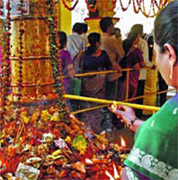 Location: Tadparti near Anantapur.
Location: Tadparti near Anantapur.
Deities: Ramalingeswara (Shiva).
Location: Tadpatri, Anantapur.
This temple dates back to the 15th Century Vijayanagar Empire and has elements of Chalukyan, Chola and Vijayanagar art. The gopuram although unfinished has the most elaborate sculpture, cut with richness and sharpness. There are two famous temples here - the Bugga Ramalingeswara temple and the Chintala Venkataramana temple. Here the entire Siva Purana is carved in stone on the walls.
Both these temples are situated on the banks of river Pinakini. The Siva temple faces west and is more ancient of the two. This area was originally called Bhaskara Kshetras a forest having plenty of palm trees. Hence it was called Tamlapalli (Tati Vanain). During the time of Pemmasani Ramalinga Naidu, a local chieftain this place was renamed as Tadpatri. According to legend the spot where Ramalingeswara temple stands, Lord Parashurama lived and performed penance here. There is an underground source from where water flows into the garbha griha. The idol is uncut and roughly formed and hence the popular tradition that the linga is Swayambu.
The Kaifiat record royal patronage of the Vijayanagar king, built the western, northern and southern gopurams of the temple and the Mahadwara gopurams on the south. To the east is the place where Lord Parasurama did his penance. The gopuram of Sri Ramalingeswara temple, is massive and built with great attention. It is chiseled and polished and creates a majestic appearance. The records name a sculptor by name of Yellanchari brought from Benaras to work here.
The other temple Chintala Venkataramana Murti temple is dedicated to Lord Vishnu. The legend states Sri Timma Naidu built it under the orders of the Vijayanagar kings. The temple is built according to the Silpa Sastras. The garbha griha, the Madyaranga, the Astana Mantapa, the Antarala Gopura, the Prakara, the Yagnasala, and the Kalyana Mantapa etc contain sculptures from the Ramayana and Mahabharata. Originally the temple was called Chintala Tiruvengala Nathaswami. Chintala describes the Lord as Moola Bhera discovered at the foot of a tamarind tree.
The main gopura faces the east and is a solid structure, built partly of stone and partly of brick. The stone part contains figures of Vidyadhara, apsaras and avatars in neat and well-arranged rows. Just above the threshold, there are two horizontal lines of carvings one showing an elephant procession, horse procession from one end to the other. Inside the temple, every wall is covered with beautiful and delicate pieces of sculpture. A stone chariot is also there. Two holes are carved in the chariot and twice a year the Sun`s rays touch the foot of the deity.
A Rangamantapa has forty pillars in the Vijayanagar style. Beyond the Rangamantapa is a Mukhamantapa, which has scenes of the Ramayana commencing from Putrakameshti Yagna of Dasharatha to the Pattabhisheka of Sri Ramachandra. There are rare sculptures of the incarnations of Vishnu. To the north of the main temple, there are shrines dedicated to the goddesses. Adjacent to the Paryanka Griha, is built in the shape of an octagon.
Festivals: The important festivals held here are Narakachaturthi and Brahmotsava that fall in the month of October. In the Siva temple, the Vijayadasami and the Brahmotsava are celebrated in September and February.





















